Health Assessment Report: Comprehensive Analysis of Mr. X's Case Study
VerifiedAdded on 2020/04/07
|7
|1508
|439
Report
AI Summary
This report details a health assessment conducted on Mr. X, a 65-year-old patient diagnosed with cholecystitis. The assessment encompasses demographic data, including his medical history of diabetes, hypertension, and gallstones, along with a review of his current symptoms such as diarrhea, abdominal pain, nausea, and vomiting. It also covers vital signs, pain assessment, developmental, cultural, and psychosocial considerations, highlighting his concerns for his wife's health. The report discusses learning needs, collaborative resources, and reflections on the assessment process, including challenges faced during pain assessment and the importance of therapeutic communication. The patient's health history assessment also includes family medical history and review of systems. The assessment emphasizes the importance of RUQ abdominal assessment and the need for comprehensive clinical support for recovery.
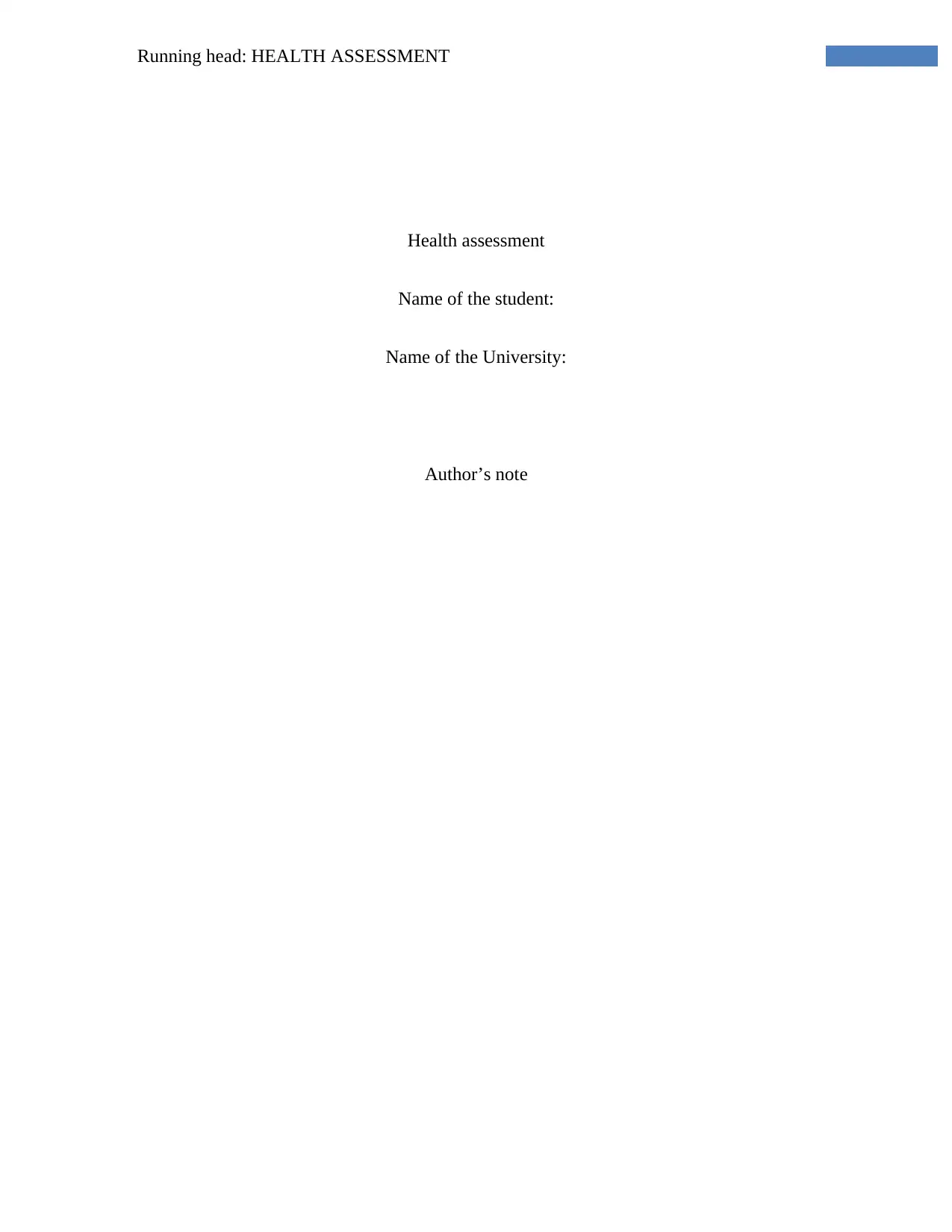
Running head: HEALTH ASSESSMENT
Health assessment
Name of the student:
Name of the University:
Author’s note
Health assessment
Name of the student:
Name of the University:
Author’s note
Paraphrase This Document
Need a fresh take? Get an instant paraphrase of this document with our AI Paraphraser
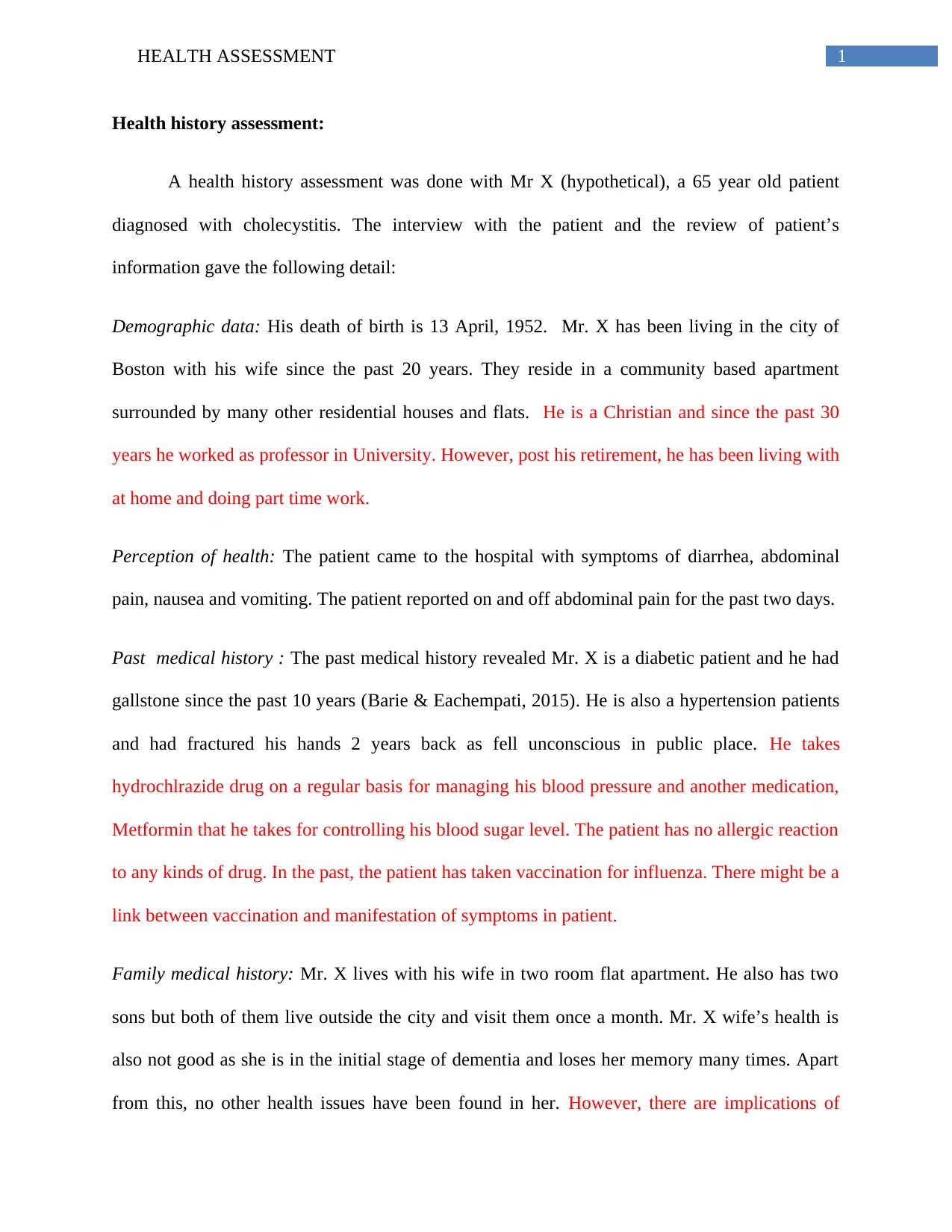
1HEALTH ASSESSMENT
Health history assessment:
A health history assessment was done with Mr X (hypothetical), a 65 year old patient
diagnosed with cholecystitis. The interview with the patient and the review of patient’s
information gave the following detail:
Demographic data: His death of birth is 13 April, 1952. Mr. X has been living in the city of
Boston with his wife since the past 20 years. They reside in a community based apartment
surrounded by many other residential houses and flats. He is a Christian and since the past 30
years he worked as professor in University. However, post his retirement, he has been living with
at home and doing part time work.
Perception of health: The patient came to the hospital with symptoms of diarrhea, abdominal
pain, nausea and vomiting. The patient reported on and off abdominal pain for the past two days.
Past medical history : The past medical history revealed Mr. X is a diabetic patient and he had
gallstone since the past 10 years (Barie & Eachempati, 2015). He is also a hypertension patients
and had fractured his hands 2 years back as fell unconscious in public place. He takes
hydrochlrazide drug on a regular basis for managing his blood pressure and another medication,
Metformin that he takes for controlling his blood sugar level. The patient has no allergic reaction
to any kinds of drug. In the past, the patient has taken vaccination for influenza. There might be a
link between vaccination and manifestation of symptoms in patient.
Family medical history: Mr. X lives with his wife in two room flat apartment. He also has two
sons but both of them live outside the city and visit them once a month. Mr. X wife’s health is
also not good as she is in the initial stage of dementia and loses her memory many times. Apart
from this, no other health issues have been found in her. However, there are implications of
Health history assessment:
A health history assessment was done with Mr X (hypothetical), a 65 year old patient
diagnosed with cholecystitis. The interview with the patient and the review of patient’s
information gave the following detail:
Demographic data: His death of birth is 13 April, 1952. Mr. X has been living in the city of
Boston with his wife since the past 20 years. They reside in a community based apartment
surrounded by many other residential houses and flats. He is a Christian and since the past 30
years he worked as professor in University. However, post his retirement, he has been living with
at home and doing part time work.
Perception of health: The patient came to the hospital with symptoms of diarrhea, abdominal
pain, nausea and vomiting. The patient reported on and off abdominal pain for the past two days.
Past medical history : The past medical history revealed Mr. X is a diabetic patient and he had
gallstone since the past 10 years (Barie & Eachempati, 2015). He is also a hypertension patients
and had fractured his hands 2 years back as fell unconscious in public place. He takes
hydrochlrazide drug on a regular basis for managing his blood pressure and another medication,
Metformin that he takes for controlling his blood sugar level. The patient has no allergic reaction
to any kinds of drug. In the past, the patient has taken vaccination for influenza. There might be a
link between vaccination and manifestation of symptoms in patient.
Family medical history: Mr. X lives with his wife in two room flat apartment. He also has two
sons but both of them live outside the city and visit them once a month. Mr. X wife’s health is
also not good as she is in the initial stage of dementia and loses her memory many times. Apart
from this, no other health issues have been found in her. However, there are implications of
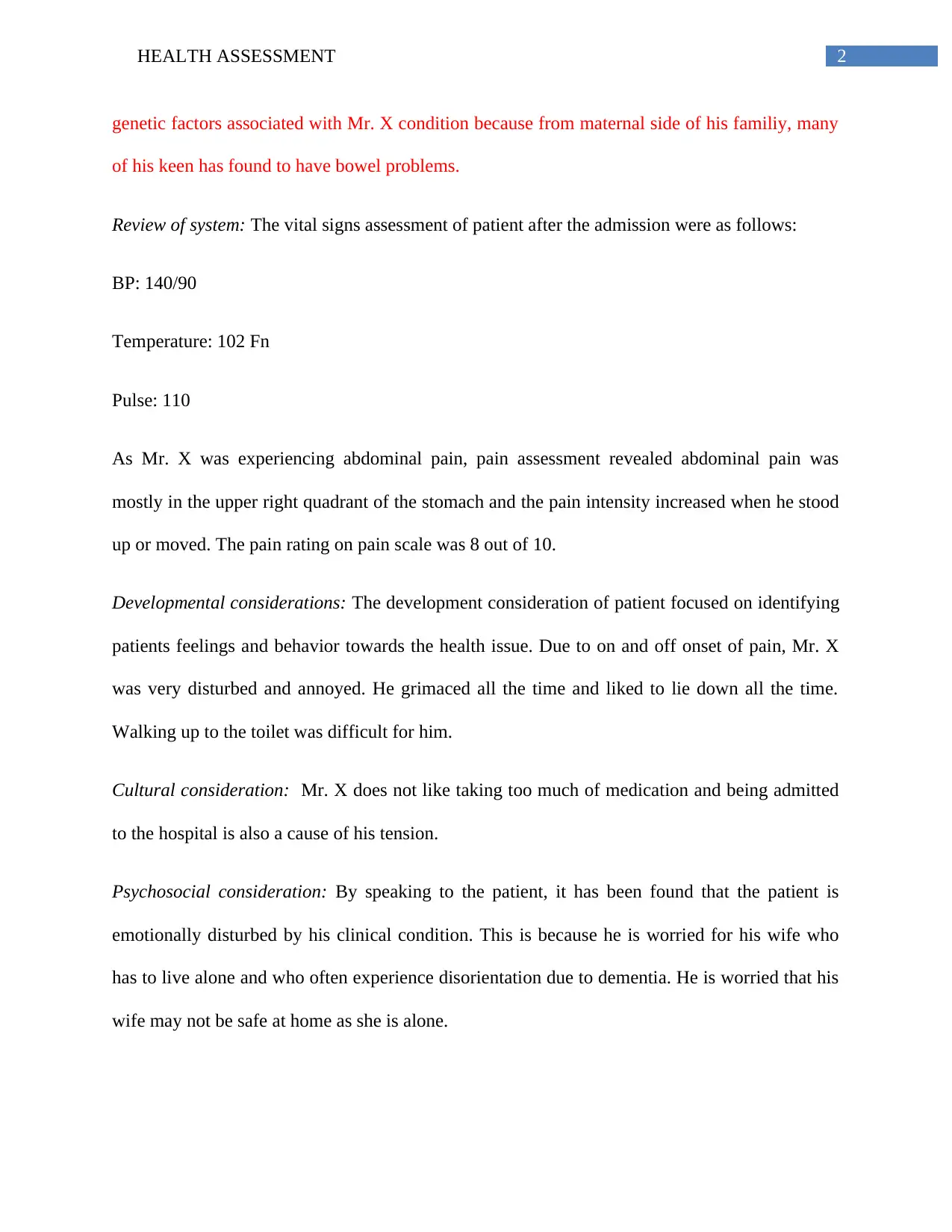
2HEALTH ASSESSMENT
genetic factors associated with Mr. X condition because from maternal side of his familiy, many
of his keen has found to have bowel problems.
Review of system: The vital signs assessment of patient after the admission were as follows:
BP: 140/90
Temperature: 102 Fn
Pulse: 110
As Mr. X was experiencing abdominal pain, pain assessment revealed abdominal pain was
mostly in the upper right quadrant of the stomach and the pain intensity increased when he stood
up or moved. The pain rating on pain scale was 8 out of 10.
Developmental considerations: The development consideration of patient focused on identifying
patients feelings and behavior towards the health issue. Due to on and off onset of pain, Mr. X
was very disturbed and annoyed. He grimaced all the time and liked to lie down all the time.
Walking up to the toilet was difficult for him.
Cultural consideration: Mr. X does not like taking too much of medication and being admitted
to the hospital is also a cause of his tension.
Psychosocial consideration: By speaking to the patient, it has been found that the patient is
emotionally disturbed by his clinical condition. This is because he is worried for his wife who
has to live alone and who often experience disorientation due to dementia. He is worried that his
wife may not be safe at home as she is alone.
genetic factors associated with Mr. X condition because from maternal side of his familiy, many
of his keen has found to have bowel problems.
Review of system: The vital signs assessment of patient after the admission were as follows:
BP: 140/90
Temperature: 102 Fn
Pulse: 110
As Mr. X was experiencing abdominal pain, pain assessment revealed abdominal pain was
mostly in the upper right quadrant of the stomach and the pain intensity increased when he stood
up or moved. The pain rating on pain scale was 8 out of 10.
Developmental considerations: The development consideration of patient focused on identifying
patients feelings and behavior towards the health issue. Due to on and off onset of pain, Mr. X
was very disturbed and annoyed. He grimaced all the time and liked to lie down all the time.
Walking up to the toilet was difficult for him.
Cultural consideration: Mr. X does not like taking too much of medication and being admitted
to the hospital is also a cause of his tension.
Psychosocial consideration: By speaking to the patient, it has been found that the patient is
emotionally disturbed by his clinical condition. This is because he is worried for his wife who
has to live alone and who often experience disorientation due to dementia. He is worried that his
wife may not be safe at home as she is alone.
⊘ This is a preview!⊘
Do you want full access?
Subscribe today to unlock all pages.

Trusted by 1+ million students worldwide
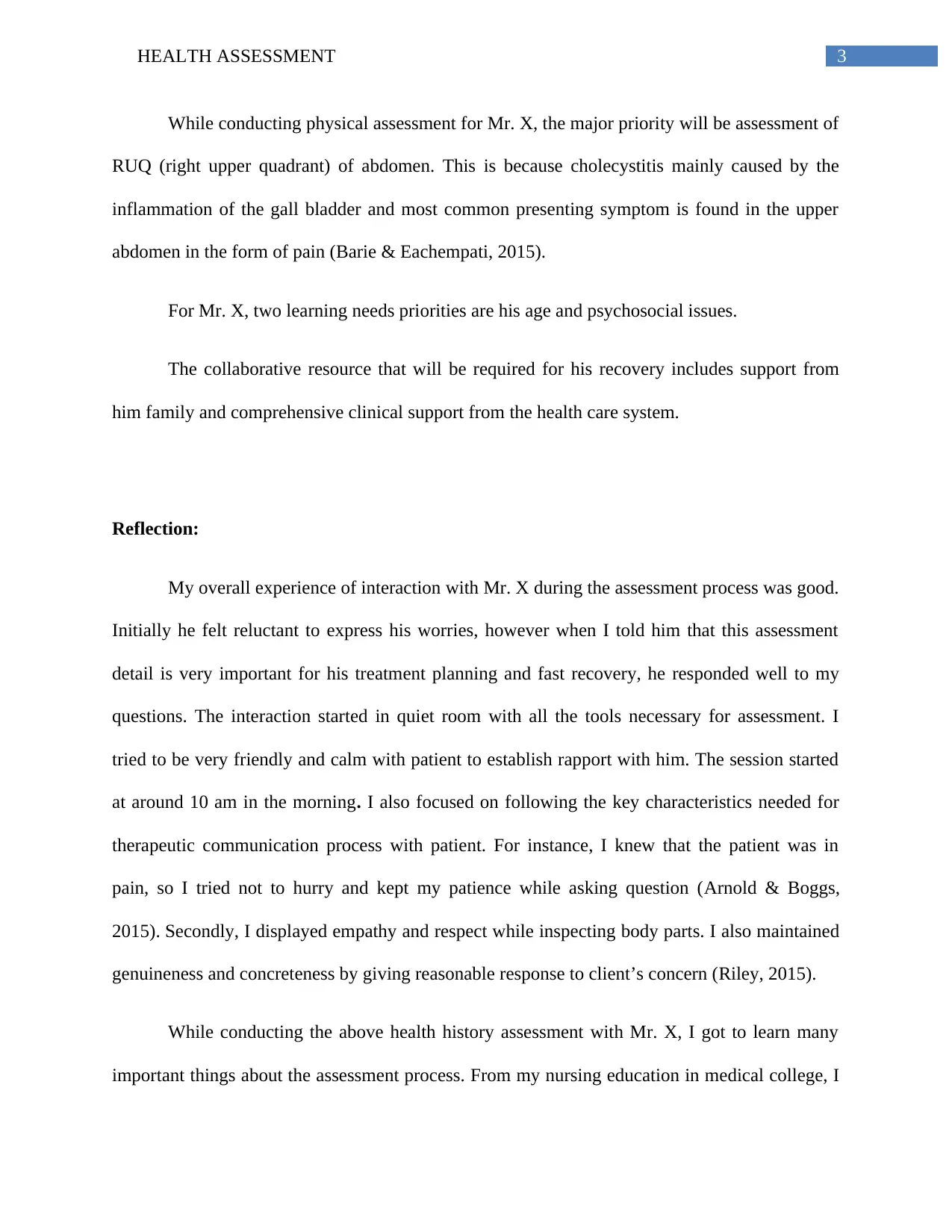
3HEALTH ASSESSMENT
While conducting physical assessment for Mr. X, the major priority will be assessment of
RUQ (right upper quadrant) of abdomen. This is because cholecystitis mainly caused by the
inflammation of the gall bladder and most common presenting symptom is found in the upper
abdomen in the form of pain (Barie & Eachempati, 2015).
For Mr. X, two learning needs priorities are his age and psychosocial issues.
The collaborative resource that will be required for his recovery includes support from
him family and comprehensive clinical support from the health care system.
Reflection:
My overall experience of interaction with Mr. X during the assessment process was good.
Initially he felt reluctant to express his worries, however when I told him that this assessment
detail is very important for his treatment planning and fast recovery, he responded well to my
questions. The interaction started in quiet room with all the tools necessary for assessment. I
tried to be very friendly and calm with patient to establish rapport with him. The session started
at around 10 am in the morning. I also focused on following the key characteristics needed for
therapeutic communication process with patient. For instance, I knew that the patient was in
pain, so I tried not to hurry and kept my patience while asking question (Arnold & Boggs,
2015). Secondly, I displayed empathy and respect while inspecting body parts. I also maintained
genuineness and concreteness by giving reasonable response to client’s concern (Riley, 2015).
While conducting the above health history assessment with Mr. X, I got to learn many
important things about the assessment process. From my nursing education in medical college, I
While conducting physical assessment for Mr. X, the major priority will be assessment of
RUQ (right upper quadrant) of abdomen. This is because cholecystitis mainly caused by the
inflammation of the gall bladder and most common presenting symptom is found in the upper
abdomen in the form of pain (Barie & Eachempati, 2015).
For Mr. X, two learning needs priorities are his age and psychosocial issues.
The collaborative resource that will be required for his recovery includes support from
him family and comprehensive clinical support from the health care system.
Reflection:
My overall experience of interaction with Mr. X during the assessment process was good.
Initially he felt reluctant to express his worries, however when I told him that this assessment
detail is very important for his treatment planning and fast recovery, he responded well to my
questions. The interaction started in quiet room with all the tools necessary for assessment. I
tried to be very friendly and calm with patient to establish rapport with him. The session started
at around 10 am in the morning. I also focused on following the key characteristics needed for
therapeutic communication process with patient. For instance, I knew that the patient was in
pain, so I tried not to hurry and kept my patience while asking question (Arnold & Boggs,
2015). Secondly, I displayed empathy and respect while inspecting body parts. I also maintained
genuineness and concreteness by giving reasonable response to client’s concern (Riley, 2015).
While conducting the above health history assessment with Mr. X, I got to learn many
important things about the assessment process. From my nursing education in medical college, I
Paraphrase This Document
Need a fresh take? Get an instant paraphrase of this document with our AI Paraphraser
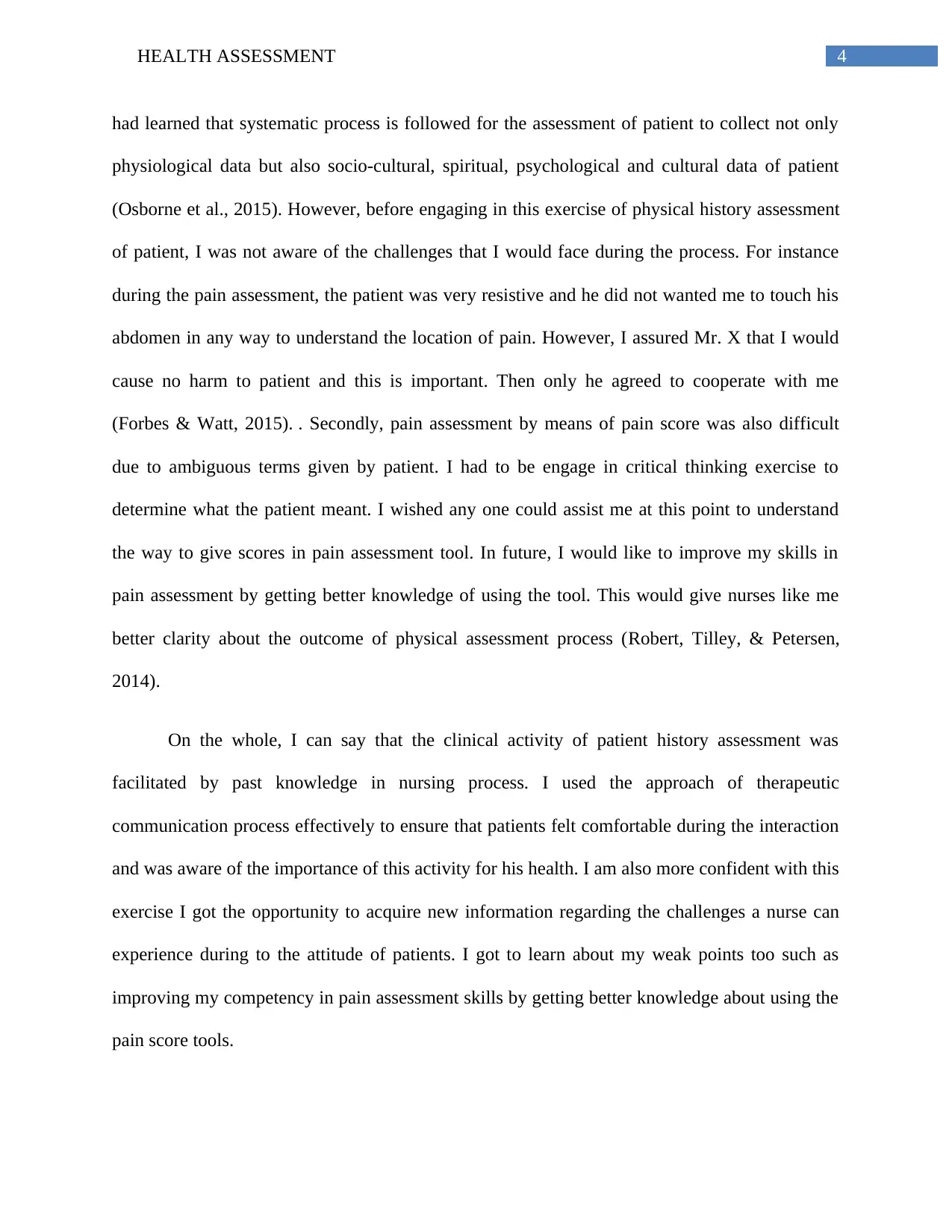
4HEALTH ASSESSMENT
had learned that systematic process is followed for the assessment of patient to collect not only
physiological data but also socio-cultural, spiritual, psychological and cultural data of patient
(Osborne et al., 2015). However, before engaging in this exercise of physical history assessment
of patient, I was not aware of the challenges that I would face during the process. For instance
during the pain assessment, the patient was very resistive and he did not wanted me to touch his
abdomen in any way to understand the location of pain. However, I assured Mr. X that I would
cause no harm to patient and this is important. Then only he agreed to cooperate with me
(Forbes & Watt, 2015). . Secondly, pain assessment by means of pain score was also difficult
due to ambiguous terms given by patient. I had to be engage in critical thinking exercise to
determine what the patient meant. I wished any one could assist me at this point to understand
the way to give scores in pain assessment tool. In future, I would like to improve my skills in
pain assessment by getting better knowledge of using the tool. This would give nurses like me
better clarity about the outcome of physical assessment process (Robert, Tilley, & Petersen,
2014).
On the whole, I can say that the clinical activity of patient history assessment was
facilitated by past knowledge in nursing process. I used the approach of therapeutic
communication process effectively to ensure that patients felt comfortable during the interaction
and was aware of the importance of this activity for his health. I am also more confident with this
exercise I got the opportunity to acquire new information regarding the challenges a nurse can
experience during to the attitude of patients. I got to learn about my weak points too such as
improving my competency in pain assessment skills by getting better knowledge about using the
pain score tools.
had learned that systematic process is followed for the assessment of patient to collect not only
physiological data but also socio-cultural, spiritual, psychological and cultural data of patient
(Osborne et al., 2015). However, before engaging in this exercise of physical history assessment
of patient, I was not aware of the challenges that I would face during the process. For instance
during the pain assessment, the patient was very resistive and he did not wanted me to touch his
abdomen in any way to understand the location of pain. However, I assured Mr. X that I would
cause no harm to patient and this is important. Then only he agreed to cooperate with me
(Forbes & Watt, 2015). . Secondly, pain assessment by means of pain score was also difficult
due to ambiguous terms given by patient. I had to be engage in critical thinking exercise to
determine what the patient meant. I wished any one could assist me at this point to understand
the way to give scores in pain assessment tool. In future, I would like to improve my skills in
pain assessment by getting better knowledge of using the tool. This would give nurses like me
better clarity about the outcome of physical assessment process (Robert, Tilley, & Petersen,
2014).
On the whole, I can say that the clinical activity of patient history assessment was
facilitated by past knowledge in nursing process. I used the approach of therapeutic
communication process effectively to ensure that patients felt comfortable during the interaction
and was aware of the importance of this activity for his health. I am also more confident with this
exercise I got the opportunity to acquire new information regarding the challenges a nurse can
experience during to the attitude of patients. I got to learn about my weak points too such as
improving my competency in pain assessment skills by getting better knowledge about using the
pain score tools.

5HEALTH ASSESSMENT
⊘ This is a preview!⊘
Do you want full access?
Subscribe today to unlock all pages.

Trusted by 1+ million students worldwide
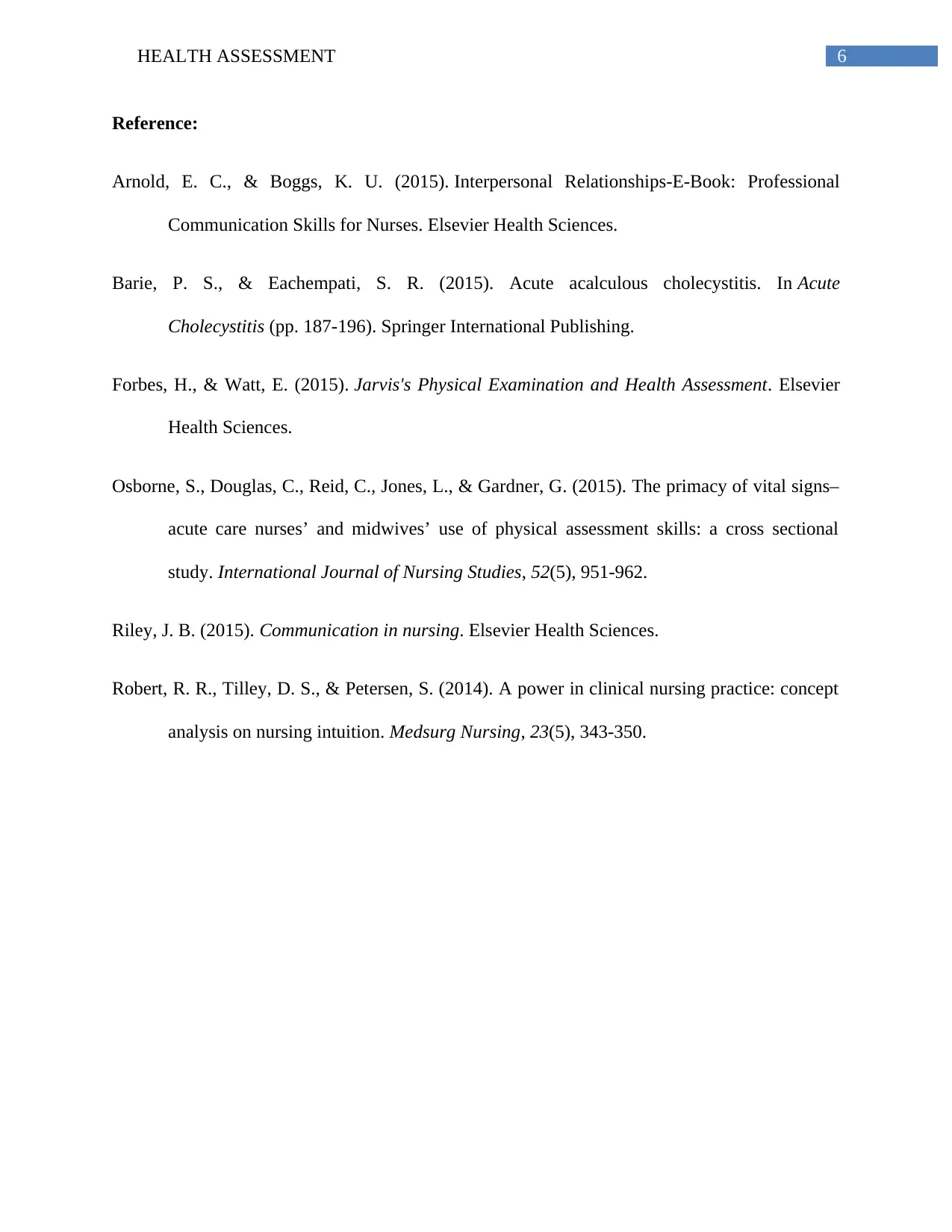
6HEALTH ASSESSMENT
Reference:
Arnold, E. C., & Boggs, K. U. (2015). Interpersonal Relationships-E-Book: Professional
Communication Skills for Nurses. Elsevier Health Sciences.
Barie, P. S., & Eachempati, S. R. (2015). Acute acalculous cholecystitis. In Acute
Cholecystitis (pp. 187-196). Springer International Publishing.
Forbes, H., & Watt, E. (2015). Jarvis's Physical Examination and Health Assessment. Elsevier
Health Sciences.
Osborne, S., Douglas, C., Reid, C., Jones, L., & Gardner, G. (2015). The primacy of vital signs–
acute care nurses’ and midwives’ use of physical assessment skills: a cross sectional
study. International Journal of Nursing Studies, 52(5), 951-962.
Riley, J. B. (2015). Communication in nursing. Elsevier Health Sciences.
Robert, R. R., Tilley, D. S., & Petersen, S. (2014). A power in clinical nursing practice: concept
analysis on nursing intuition. Medsurg Nursing, 23(5), 343-350.
Reference:
Arnold, E. C., & Boggs, K. U. (2015). Interpersonal Relationships-E-Book: Professional
Communication Skills for Nurses. Elsevier Health Sciences.
Barie, P. S., & Eachempati, S. R. (2015). Acute acalculous cholecystitis. In Acute
Cholecystitis (pp. 187-196). Springer International Publishing.
Forbes, H., & Watt, E. (2015). Jarvis's Physical Examination and Health Assessment. Elsevier
Health Sciences.
Osborne, S., Douglas, C., Reid, C., Jones, L., & Gardner, G. (2015). The primacy of vital signs–
acute care nurses’ and midwives’ use of physical assessment skills: a cross sectional
study. International Journal of Nursing Studies, 52(5), 951-962.
Riley, J. B. (2015). Communication in nursing. Elsevier Health Sciences.
Robert, R. R., Tilley, D. S., & Petersen, S. (2014). A power in clinical nursing practice: concept
analysis on nursing intuition. Medsurg Nursing, 23(5), 343-350.
1 out of 7
Related Documents
Your All-in-One AI-Powered Toolkit for Academic Success.
+13062052269
info@desklib.com
Available 24*7 on WhatsApp / Email
![[object Object]](/_next/static/media/star-bottom.7253800d.svg)
Unlock your academic potential
Copyright © 2020–2025 A2Z Services. All Rights Reserved. Developed and managed by ZUCOL.




